Context
Valladolid demo-follower consists of an existing biomass-based District Heating (100% renewable energy). It was built in 2016 and operates since 2018.
The demo-follower is located in the urban area of Valladolid, 250 km northwest of Madrid. Valladolid (latitude 42°) is located at roughly 735 metres above sea level. It has a continental climate with cold and windy winters, due to altitude and an inland location, and hot summers, raising maximum temperatures up to 30 C. It is not a very rainy region, rain being more frequent in autumn and spring.
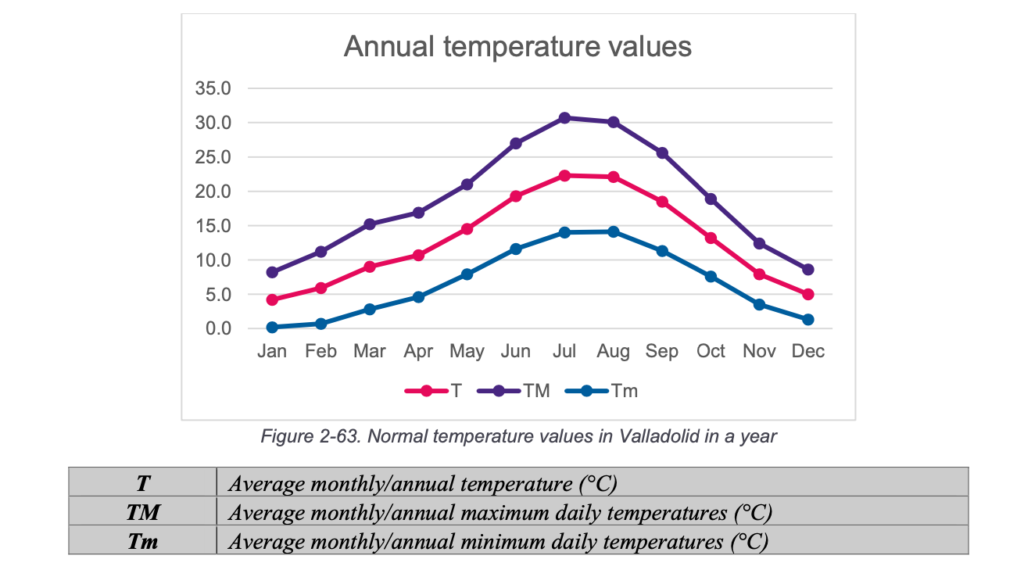
The availability of direct normal radiation is quite good for Valladolid.
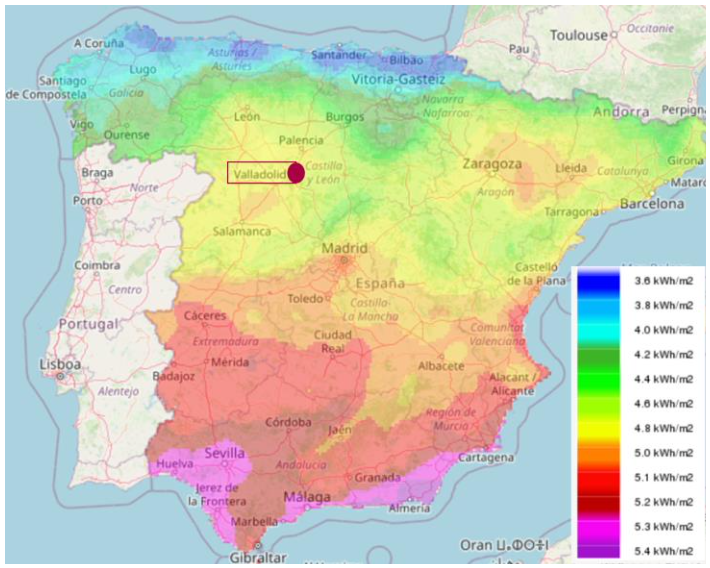
Seasonal analysis shows that Valladolid had less sunshine in autumn and winter but high potential for solar energy in summer.
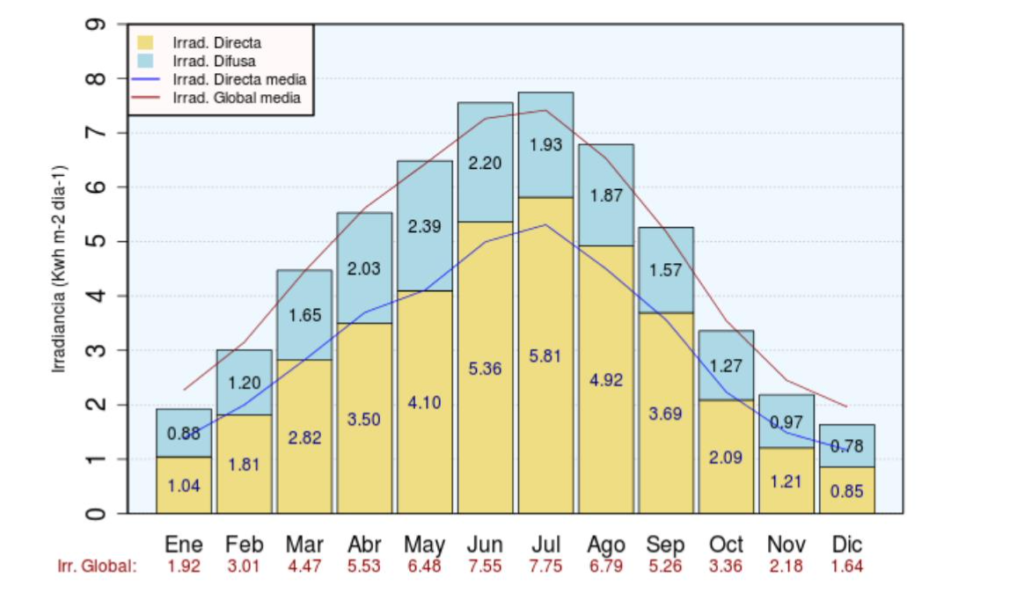
Valladolid has a total population of approximately 300,000 (in 2020). The city lies along the Pisuerga River, the demo-follower and the connected buildings are located near that river.
Area
The DH is currently serving a total of six buildings, four public buildings of different size, including offices for public administrations, and two housing communities. In total, the DH covers an area of 53,400 m2.
Valladolid installations are composed of two biomass boilers of 3.48 MW each, having a peak power capacity of 6.96 MW. The DH provides only heating to the connected buildings; DHW and cooling is not covered by the network.
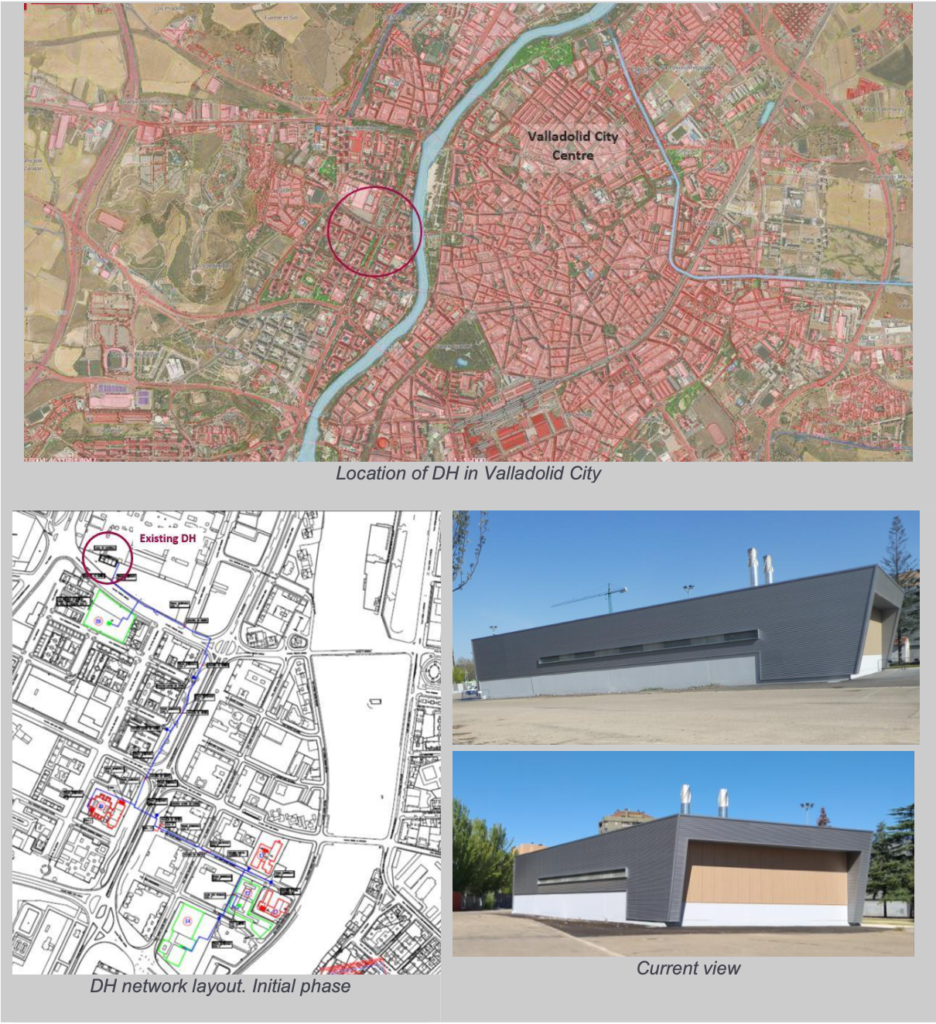
Energy demand
In 2020, the total heat consumption of all the buildings connected to the DH network was of 3 GWh.
The DH is functioning from January to May and from October to December. It is stopped from June to September, when heating is not needed.
The buildings with higher heating needs are the public buildings 3 and 4, and the two housing communities.
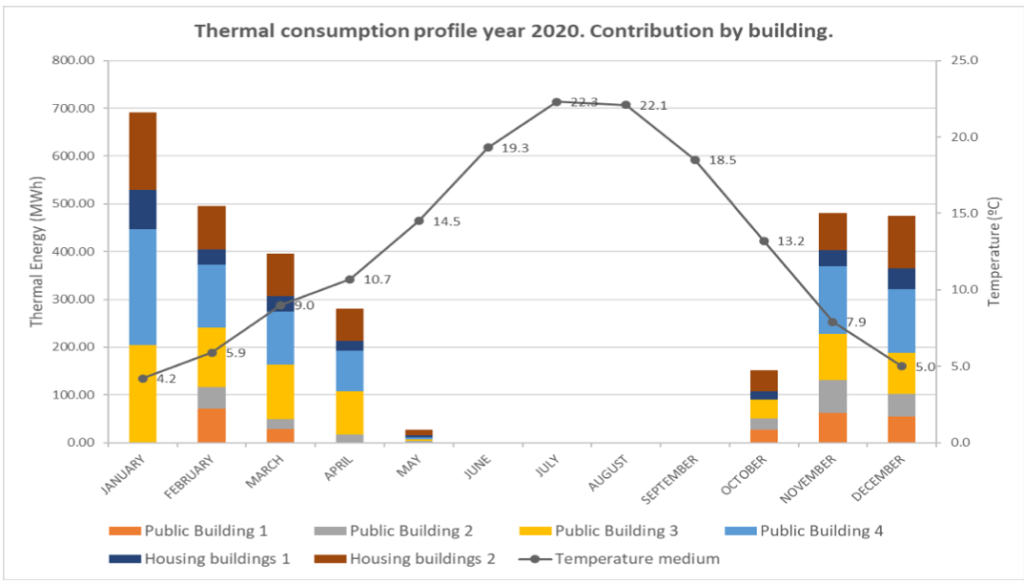
The biomass consumption needed for the heat production from December 2019 to November 2020 is shown below. A total of 1,250.2 tons of wood chips was consumed by the boilers from January to November 2020. There is no data for December 2020 yet, but if we use the data from December 2019 as reference to complete the series, the estimated amount of biomass used to produce the 3 GWh demanded heat in 2020 is approximately 1,500 tons should be related to the thermal energy consumption profile provided in the figure above, being January and February the months reaching the higher consumption of biomass. Since there is no district cooling nor DHW, there is no fuel consumption at all from June to September.
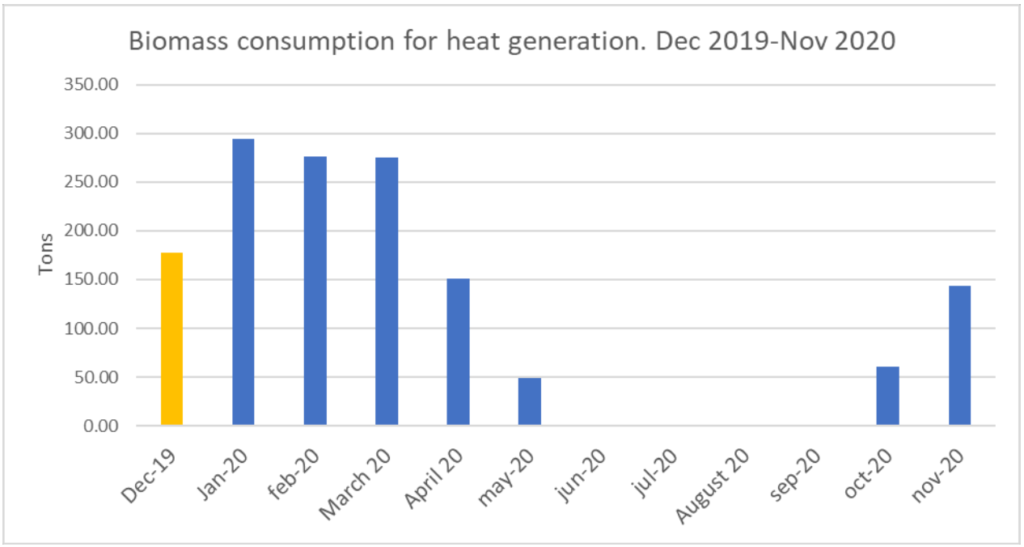
The estimated monthly breakdown for the thermal energy produced in the biomass boilers in 2020 is provided below:
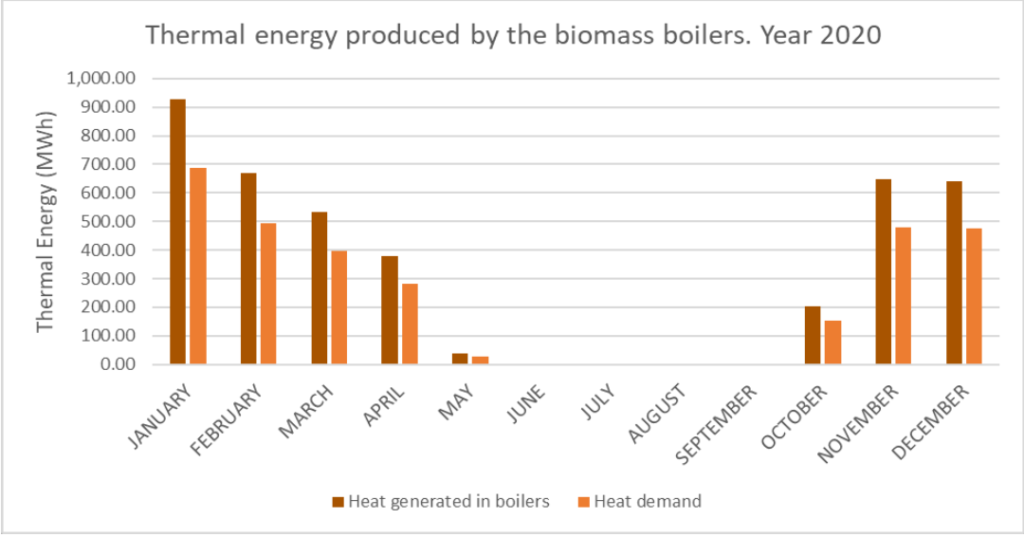
All data presented above refers to 2020, and therefore It should be taken carefully, as it might be impacted by Covid crisis.
In addition to the fuel expenses to produce the heat, Valladolid thermal plant reported an electrical consumption of 123.5 MWhe (from October 2019 to September 2020) to cover the electrical consumption of the equipment. The energy consumption reflects the intense use of the equipment (boilers and especially pressure units) in winter and autumn to catch up with the heating demand.
No electricity consumption was devoted to thermal applications, since Valladolid heat source is currently operated 100% on biomass, with no share of electrical supply.
The breakdown of electricity consumption per month is provided below. Again, since there is no data available from October 2020 to December 2020 yet, the equivalent months of 2019 have been taken as reference to complete the year series.
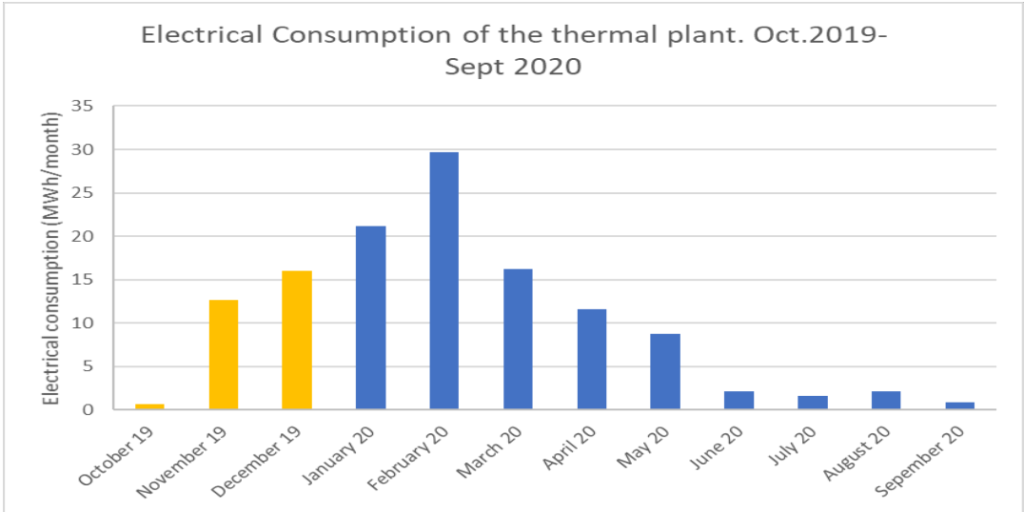
A preliminary assessment of Valladolid DH led to the following proposals:
Extension of the existing DH to add new customers
Integration of DC in the existing facilities and in the potentially extended facilities (with new customers)
Free cooling recovery from the river
Integration of PV system for electricity consumption.
Proposed technologies

Low emission biomass boiler
Extension of the current facilities using low emissive biomass boilers (if space is available), since the logistics for the biomass supply are already solved.

Economiser/ flue gas heat recovery system
Increase efficiency of existing biomass boilers by recovering the heat (partially or totally) in the flue gas released to the atmosphere

Solar technologies
Integration of solar thermal panels in the central station (if space is available) to cover heating load or cooling load of new customers.

PV panels and heat pump
Integrate PV panels in the roof plus a heat pump to generate heat. Excess electricity from the heat pump can be used to cover electricity needs of the thermal plant (or even sell electricity to the central grid).

PVT panels
Simulate the efficiency of PVT panels compared to PV panels + Heat pump tandem or solar thermal panels

Hot water/Molten salts storage
Optimised water storage sized for acting as buffer for added new renewable technologies (new solar or biomass)

Advanced Absorption chiller
Add WEDISTRICT absorption chiller to the current/extended thermal plant to allow cooling in summer. Compare its performance with the performance of commercial single and double effect absorption chillers

Renewable air-cooling unit (RACU)
Integrate RACU in specific locations of the buildings to allow cooling
Free cooling using river water
Analyse the possibility of exploiting the water from the river, improving the efficiency of a heat pump or absorption chiller
Proposed solutions
The combination of the different technologies generates three main solutions which will be studied in the next step (other solutions might arise during the activity):
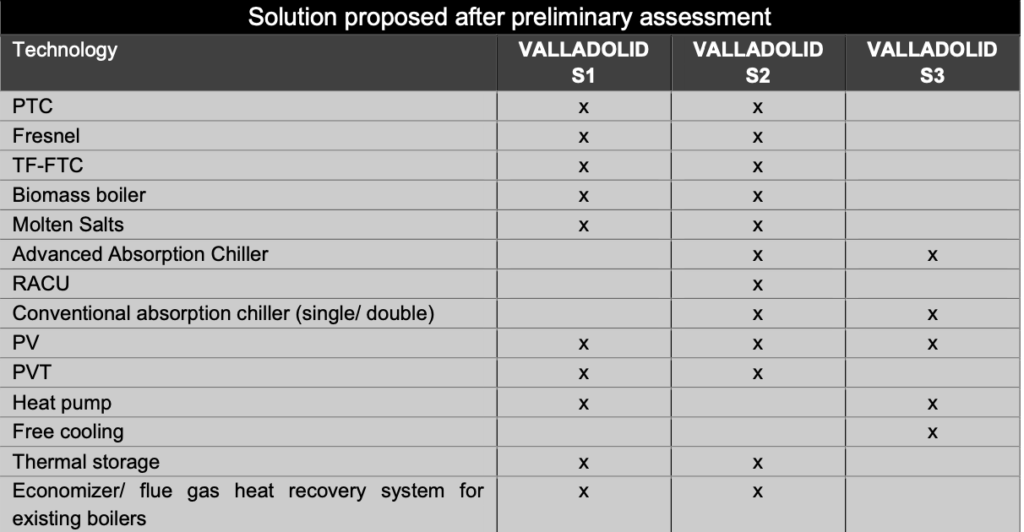
Solution 1
The first solution proposed is the extension of the existing DH. The preliminary assessment indicated that the thermal plant is working below capacity and more buildings could be connected to Valladolid DH.
The first step proposed is to simulate the addition of new clients to the current installations. Moreover, in order to increase the energy efficiency of the existing boilers, the integration of an economiser/ flue gas heat recovery system (to recover heat from boiler’s flue gas) will be assessed.
In addition, it is also proposed to extend the current thermal plant by adding new renewable sources in order to cover the connection of potential new clients. Based on the results of radiation for Valladolid, it makes sense to study the integration of solar technologies.
The best configuration of technologies will be assessed:
Addition of new biomass boilers (low emission): if there is enough space in the current DH boilers room.
Addition of photovoltaics (PV) panels on the roof of the thermal plant and/or the roof of the surrounding buildings. The PV panels can be connected to a heat pump to generate heat on the one hand, and on the other hand, cover electricity needs of the thermal plant. If there is excess of electricity from the PV panels, it can be pushed to the electrical distribution network and supply surrounding buildings.
It is suggested to investigate the use of PV-T panels instead of PV panels as an optimization.
Addition of thermal solar panels field if land is available
Addition of thermal storage: for PTC or Fresnel, molten salts storage would be integrated; for TF-FTC, water storage.
In addition to resource availability, also the availability of space has to be assessed in more detail in order to select the best alternatives for the study. The optimal operation of the plant will also be assessed (for example, if solar technologies are added, propose prioritise solar to biomass in order to save fuel).
Expected Impact
Increase efficiency of current installation
Increase generation plant capacity to cover new residential building development
Maximise solar resource
Include DHW demand, currently not covered, if necessary
Evaluate availability of biomass and cover extra heating load
Evaluate hybridisation of various renewable technologies
Avoid the CO2 emissions associated with the potential new customers, who are currently consuming fossil fuel-based heating
Solution 2
The second solution is the Integration of district cooling. Valladolid climate is very hot in summer and as a consequence, the use of individual air conditioner systems to reach comfort conditions in buildings is a general practice in summer, especially in public buildings, where offices and other public services are placed.
Valladolid DH is currently serving four public buildings, so we estimate that there is a significant demand for cooling during the summer (from June to September). In addition, as has been presented in the previous section, the boilers in Valladolid are shut down from June to October. Therefore, in order to increase the efficiency of the current DH, the alternative of integrating DC to the system seems to be a promising option. Various alternatives that can be assessed:
Add absorption chillers connected to the existing biomass-based DH plant and to potentially extended DH based on additional renewable sources.
If less cooling demand is to be covered, addition of air cooling-RACU to specific locations (such as offices). The RACU would be fed by the DH network (extended or not extended).
Add photovoltaics (PV) panels to the roof of the thermal plant and/or the roof of the surrounding buildings, in order to cover the electricity consumption of the Central Station.
Expected Impact
Provide cooling and DHW service, which are currently not covered
Remove the individual cooling systems from buildings (and avoid associated CO2 emissions)
Use the thermal plant during summer, increasing the overall efficiency of the system
Maximise biomass resource
Increase the comfort of the connected buildings in summer and reduce the electricity bills
If solar panels are added to respond to cooling demand, maximise solar resource
Solution 3
Exploit the nearby river to implement free-cooling/heat condensing. The water can be pumped up and used to ensure the condensation of the refrigerant in the heat pumps. The heat pumps can be connected to PV panels to maximise solar resources. The condensing circuit of an absorption chiller could also be studied by this option.